Ford E-Transit Custom van review (2025)
The UK's most-popular van, but in electric form
PROS
- Like the excellent Ford Transit Custom, but electric
- Choice of three power outputs
- Long service intervals
- Excellent array of body shapes
- Great standard equipment
CONS
- Range is good but not amazing
- Only one battery option
- Payloads are often below 1,000kg
- High spec means no budget base model
- High-power MS-RT feels underwhelming
Summary
The Ford Transit Custom is routinely the best-selling commercial vehicle, so an electric van version is automatically important.
It was notable that the previous model never came as an EV, with only a plug-in hybrid as an alternative to the diesels that make up most of the market. So the all-new Ford Transit Custom coming with an E-version is officially a big deal.
What is particularly notable is that this van, like several other of the more modern commercial vehicles, was designed to be electric from the outset, so there are none of the compromises that have come on some vans that have had batteries and motors shoehorned in. No matter if you go for a diesel, plug-in hybrid or a fully electric Ford Transit Custom, you will get the same cabin and loading bay layout. The only differences are under the bonnet and in how it drives.
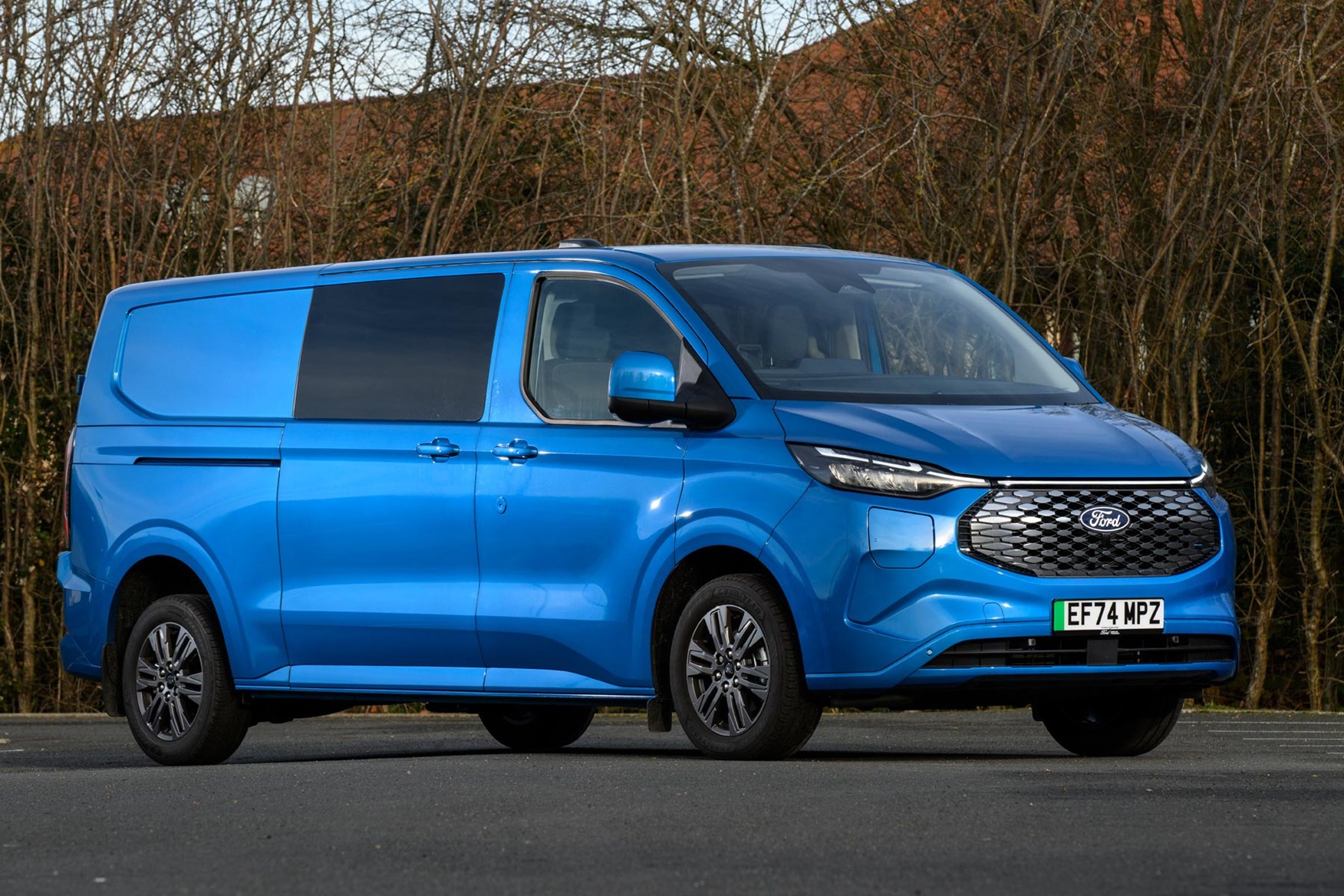
Saying ‘It’s the same as the others’ might not sound that interesting, but it is particularly important. You can fit the same racking systems and features in the rear and there are no compromises in the cabin in terms of practicality or layout. This is a good thing.
It also means that you get the Transit Custom’s quality fit and finish, high-end levels of equipment and great driving abilities.
What versions of the Ford E-Transit Custom can you buy?
Long gone are the days of a solitary electric version of a van – with the Ford you have a wide range of choice when it comes to the E-Transit Custom. You can get it in four body styles – panel van, double-cab-in-van with two rows of seat, Kombi with space for up to eight and the Multicab with its innovative new L-shaped bulkhead.
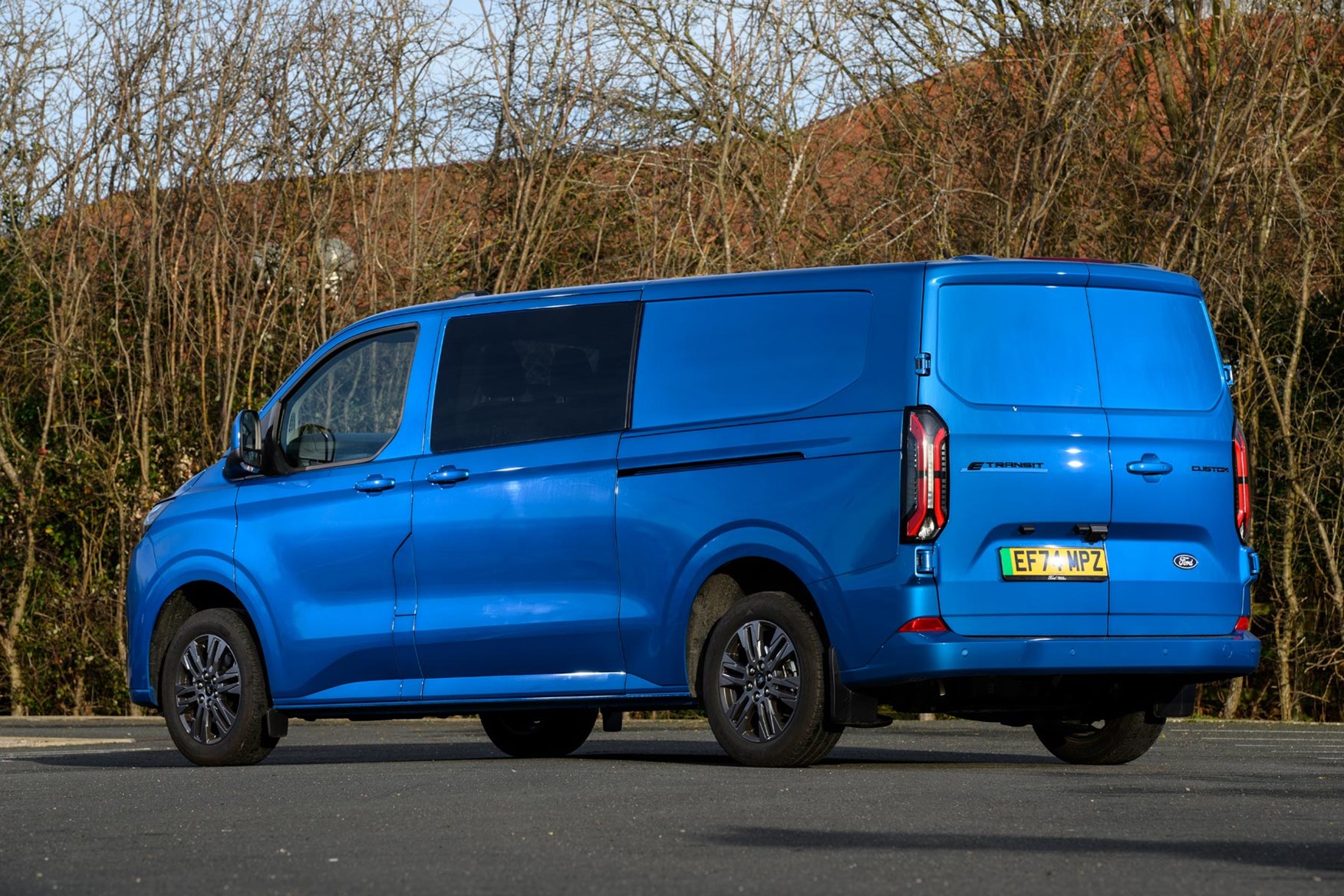
There is also the choice between two lengths and four trim levels. These are Trend, Limited, Sport and even MS-RT. The latter used to take existing vans and jazz them up with body kits and the like, but the tuning company has been brought in house, to the extent that it’s almost better to view it as a trim level rather than a tuner doing its work after the event.
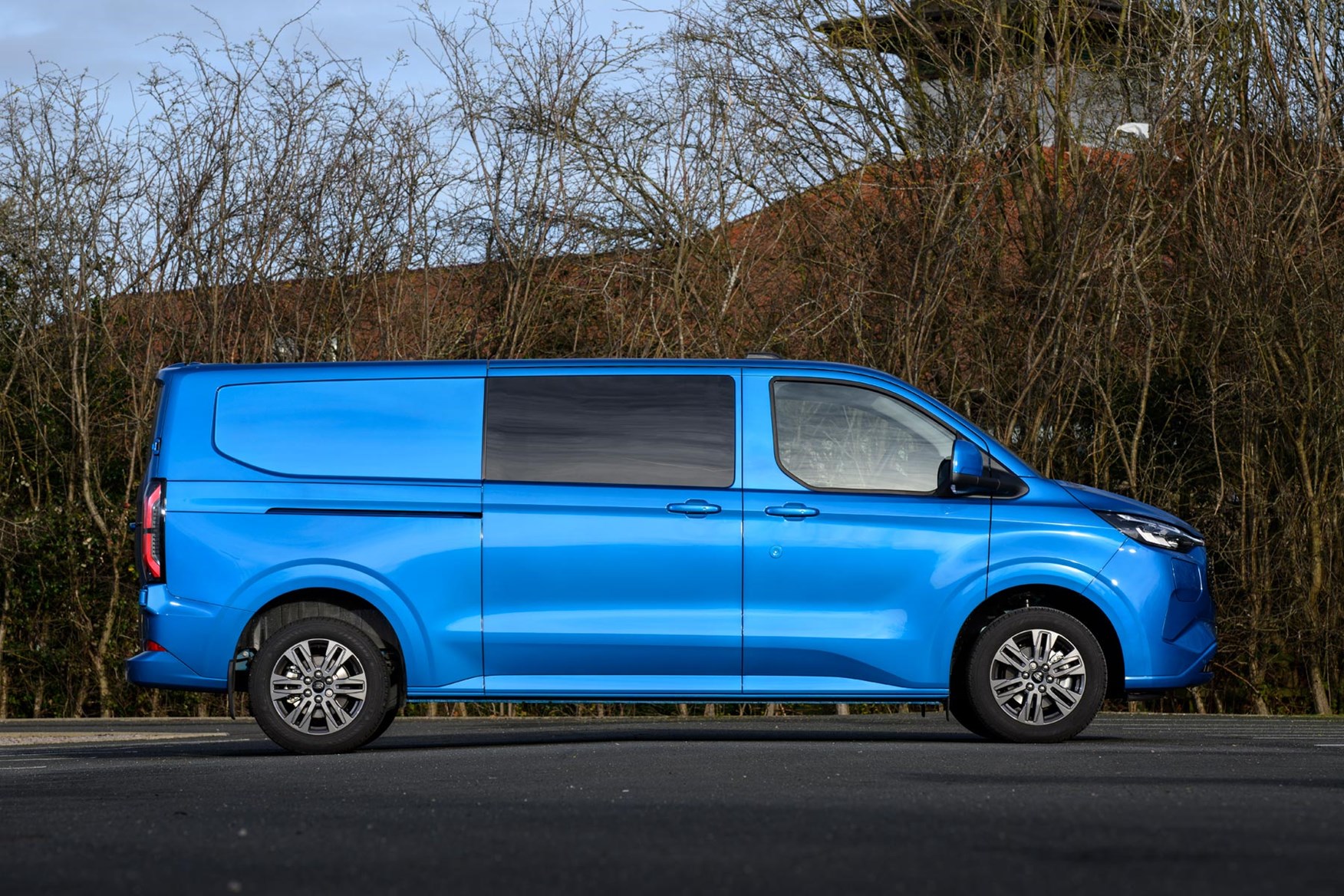
Then there is the more passenger-centric Tourneo model, which is much more of a luxury people mover than predecessors have been.
What are the Ford E-Transit Custom’s rivals?
Ford is relatively late to the party in this sector, and pretty much every other brand has an electric version in its mid-size van offering. The core competitors are the Stellantis quintet, with the Citroen e-Dispatch, Peugeot e-Expert, Fiat E-Scudo, Vauxhall Vivaro Electric and Toyota Proace Electric being the first decent medium electric vans on the market. They also remain competitive thanks to their recent updates.
The Renault Trafic E-Tech is also a relatively recent addition to the class, and is not as compromised as it could be given it is a conversion. The Mercedes-Benz eVito’s battery upgrade brought it into the realms of competitiveness, too. Other rivals come from the left field, with the B-On Pelkan and Maxus eDeliver 7 both available from lesser-known brands.
VW doesn’t have an electric Transporter for now. The new Transporter will be the same basic van as the Transit Custom, though, meaning it'll be almost exactly the same van with a VW badge on crucial elements.
Verdict: is the Ford E-Transit Custom any good?
Ford has put some real thought into this van, and the support network it is offering will be a real boost to some small businesses – it will help out with everything from maintenance to getting you a charger installed.
In short, this is a great electric van. The electric version itself might not move the game on in quite the same way as the diesel Transit Custom did when it was launched, but that is because they are so similar to one another. It doesn’t need to change the game on its own as the whole Transit Custom is such a fantastic package. This electric version just happens to be powered by a different type of engine.
Skip to our full verdict on...
- Lots of configuration possibilities
- Fantastic ride
- Can be punchy, but not outright fast
Unusually for an electric van there is more than one power output offered in the Ford E-Transit Custom range. There are, in fact, three options. The one that will make the most sense for plenty of buyers, on paper at least, is the least powerful 136hp model. Then there is a 218hp version and a bonkers 285hp MS-RT option. The latter is the most powerful Transit Custom ever.
What is the Ford E-Transit Custom like to drive?
The Transit Custom is a fantastic van to drive, as has been the case with many of its predecessors and siblings, and the electric version continues this well-established tradition.
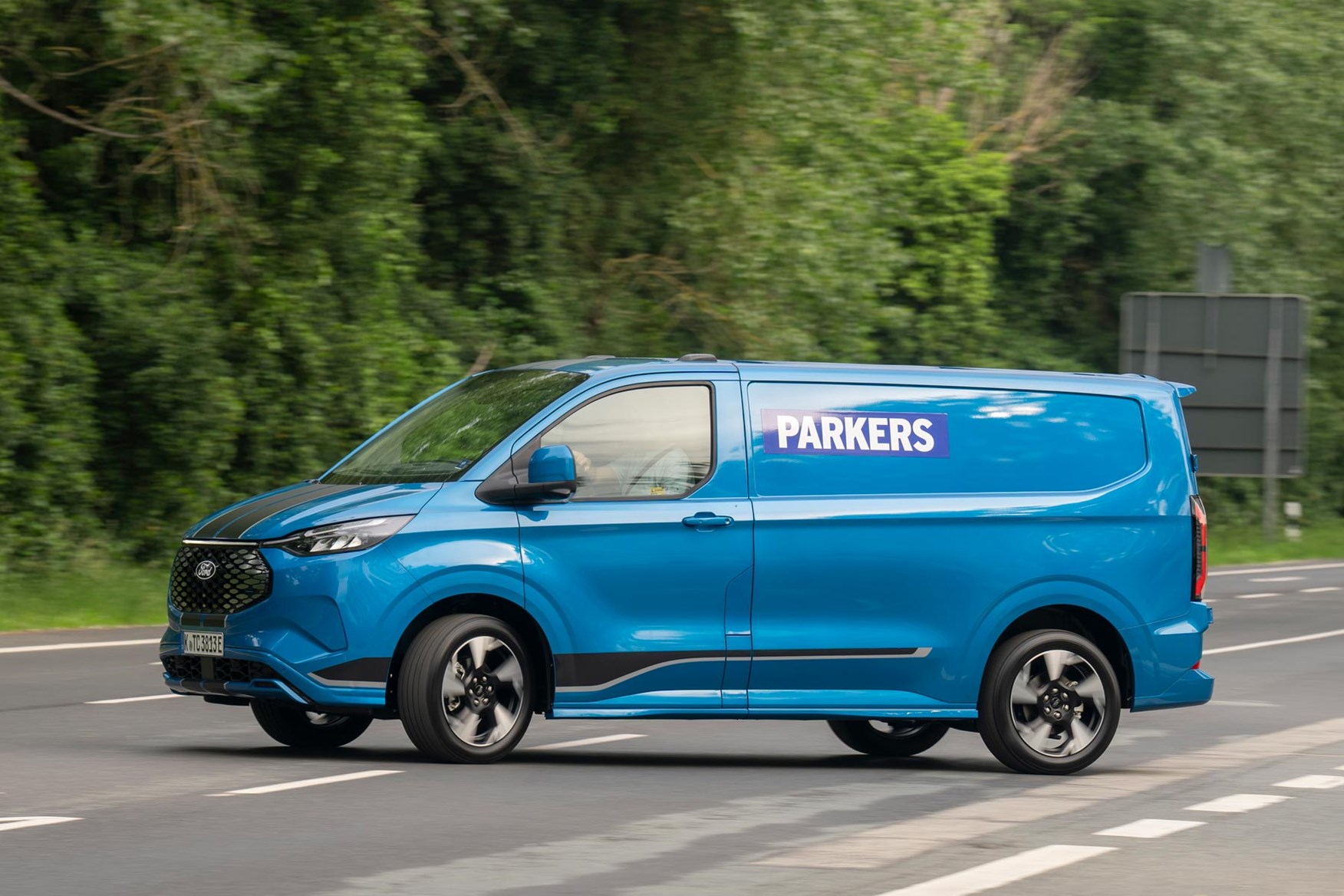
In many senses, this is the electric van that is closest in driving feel to its diesel counterparts, certainly in the medium sector at least. The ride, handling and implementation of the major functions all feel remarkably close to the diesel version, which is perhaps little surprise given the two were developed alongside one another.
This means that it feels more car-like to drive than its predecessor, with the steering lighter than before. This may or may not be a great thing, depending on your take on such matters, but the end result is a van that is easy to drive around town, where lots of turning of the wheel is often needed to squeeze in and out of tight spots.
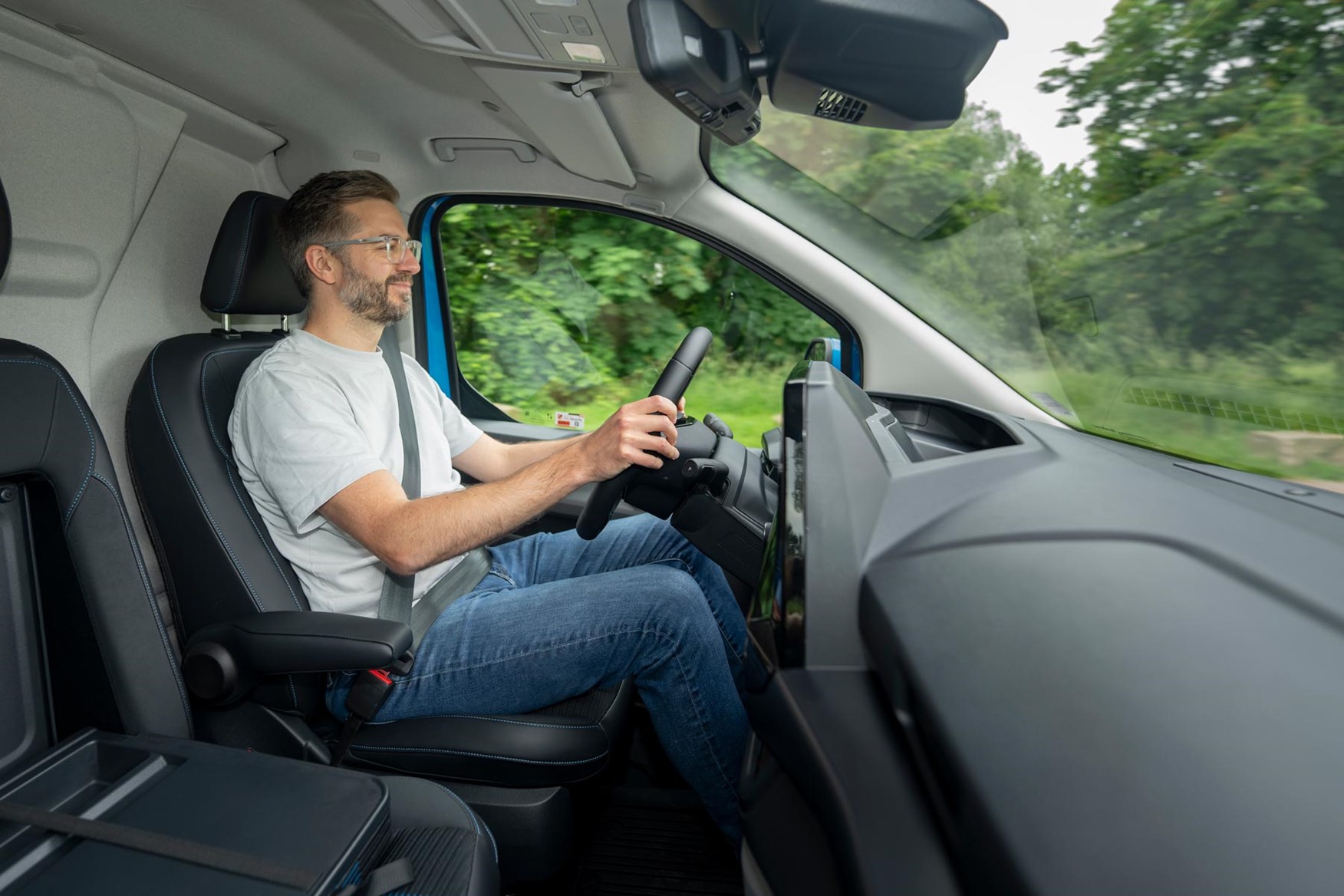
It’s a bit of a shame as the solid steering feel of the previous generation was one of its assets. It’s still got enough stability at speed to easily hold its line in a lane, but the firmness has been reduced slightly.
The ride is fantastic, too, even over the lumps and bumps that town driving throws at you. The low-down weight distribution and payload we had in the back on our test drives will have helped with this a little, but it performed admirably on all situations we threw at it.
What motors and batteries does the Ford E-Transit Custom come with?
The E-Transit Custom is a rarity in the electric van sector in that it has more than one motor to choose from. If you factor in the tuned MS-RT version there are three different options.
The entry-level version comes with a 136hp motor, and this is what you get on the two lower trims, Trend and Limited. Higher-end Sport models get a 218hp motor, and this is the version we have tried so far.
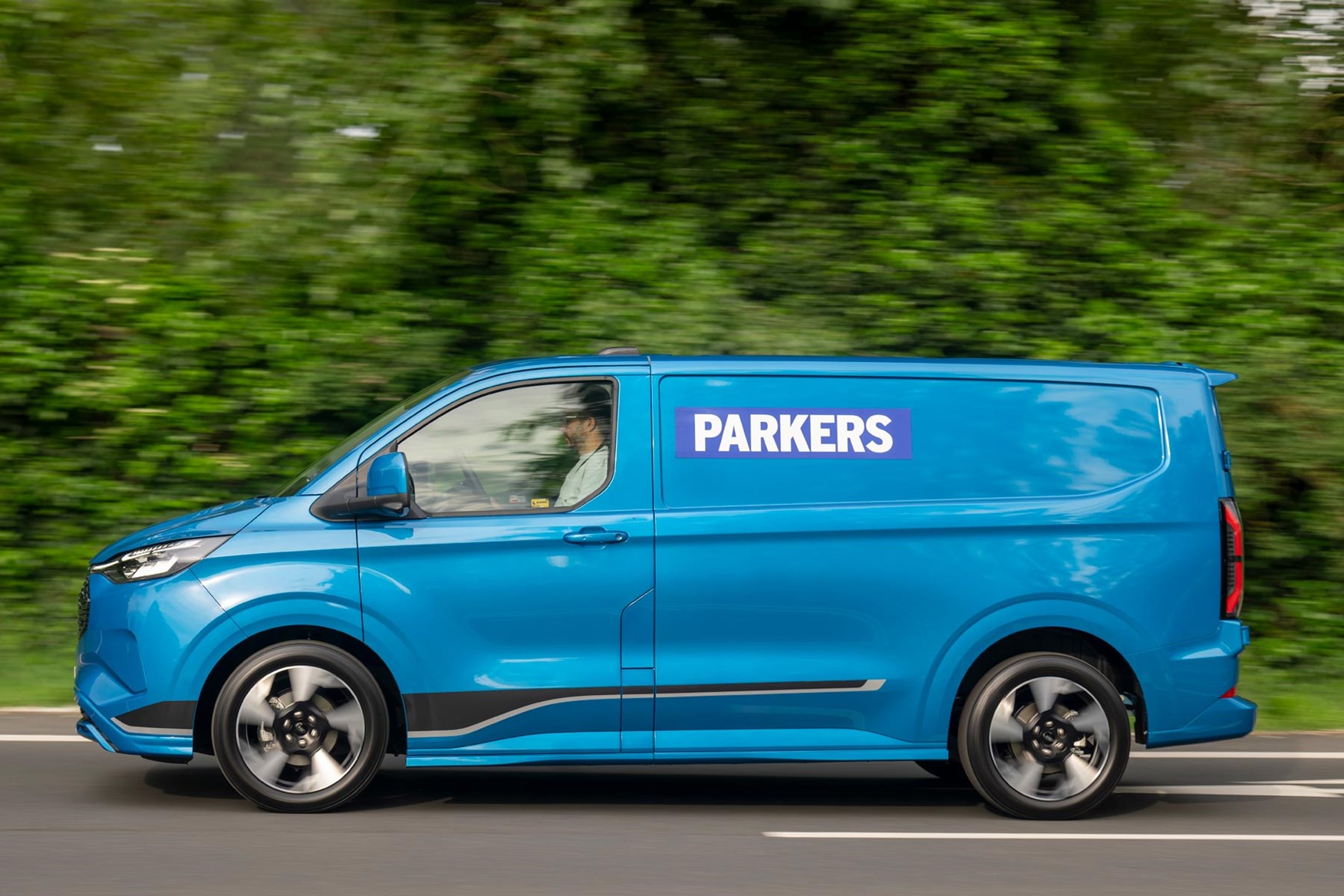
It’s a smooth and punchy motor, which has a wide range of driving modes to help you make the most of its power. The biggest difference between the three settings is the amount of acceleration you get. Eco notably dials everything back as well as doing the usual restricting of climate control power, while Sport gives you everything it has got, while also tweaking the driving dynamics. This isn’t massively noticeable, but there is a slight increase in the weightiness of the steering.
One-pedal driving
There is also an ‘L’ button on the gear shift selector (which is tucked where the indicator stalk normally is, in a bid to save space) that increases the brake regeneration. What there isn’t is a set of paddles for increasing the levels – it is either on or off. This increases the simplicity of the settings – you don’t feel like you are constantly tweaking the modes to get the optimum combination for your driving situation.
The brake regeneration won’t take you all the way to a standstill in Eco with ‘L’ engaged, but there is another option buried in the driving settings screen – you can choose a one-pedal mode. This means that it will indeed brake you all the way to a stop at the lights, firmly but progressively.
Having this setting engaged in combination with ‘L’ mode while driving on the motorway means that you have to keep a careful watch on your accelerator pedal – even lifting off slightly results in the van slowing down notably. You either need a steady foot or to engage cruise control to keep it smooth and at a steady pace.
- Clever cabin
- Quiet on the move
- Low roof means reduced storage
The E-Transit Custom gets all the same clever features of the diesel model, but with even more space potential.
Plenty of room for passengers
There are a couple of features in the new Ford Transit Custom that make the cabin a great place for adult passengers. The flat cabin floor is a particularly welcome and innovative one. It means that sliding across to get in or out of either side is really easily done, and it provides a bit more legroom for the middle passenger.

The other bonus is that all the main driving controls – gear lever and parking brake – are enacted via small stalks or buttons up on the dashboard. This means that there are no large intrusions into the space where a middle-seat passenger’s legs would go.
This is the same as the diesel model with the automatic gearbox, but isn’t the case in the manual.
Storage good in places
Because Ford has put the passenger airbag up in the roof there isn’t any storage above the occupants’ heads, as has often been the case in the past. Because of the low roof, the cabin can feel a little claustrophobic than vans have historically, but this is by no means unique in the modern mid-size sector, and the windows are big enough to make sure it feels airy and it’s easy to see out.
There are some storage highlights, though, including a section under the passenger seat that is large enough to keep the charging cable and quite a few other things tucked out of sight and not sliding around in the rear loading bay. There are also a couple of door pockets and a load-through hatch for longer items to poke through from the rear of the van.
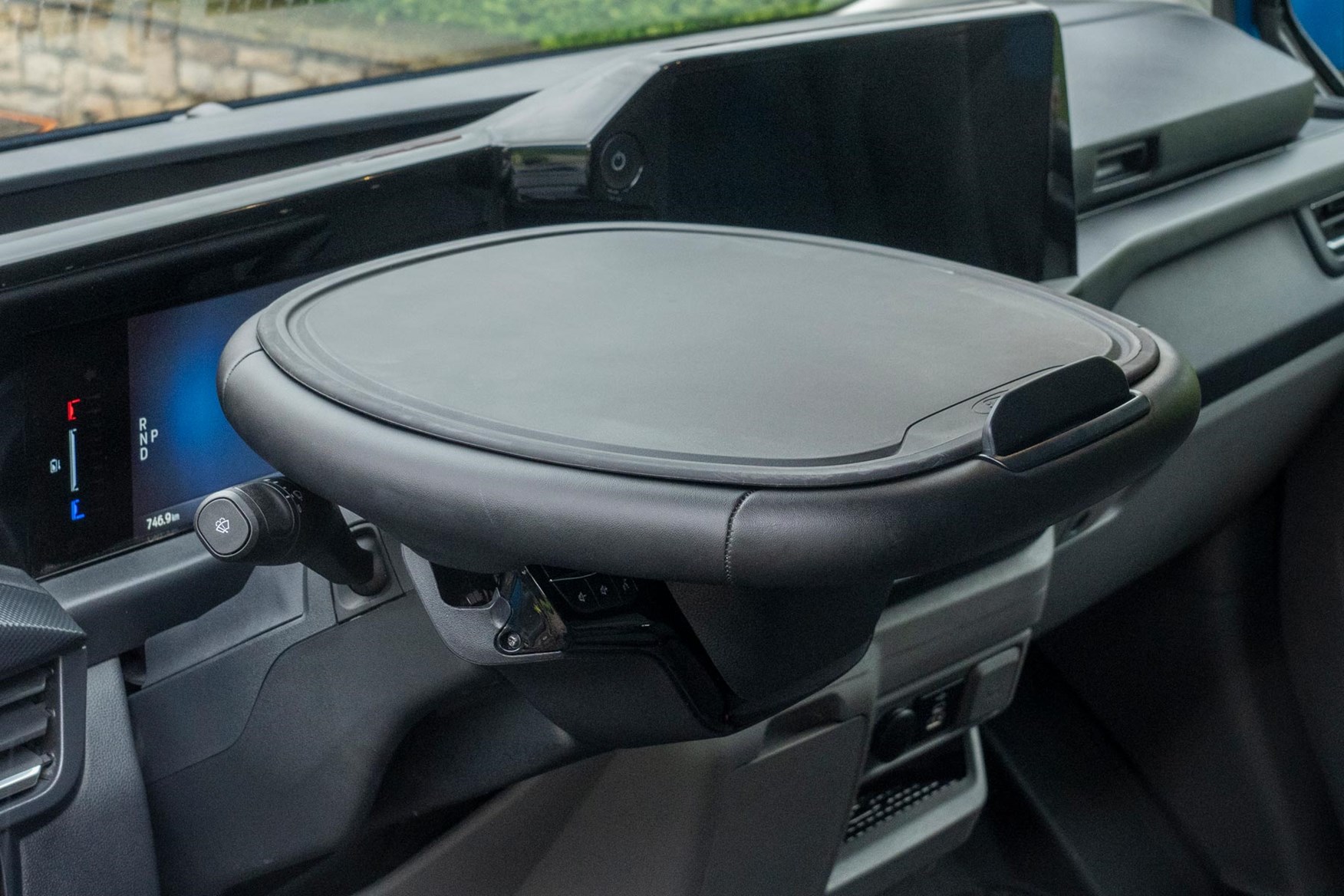
The other really clever touch is the optional steering wheel that allows you to flip the rim up to lie flat. You can then put a little tray onto it to create a small table. Ideal for those lunches on the go. It can't be operated while you are moving, though - the van has to be in P for it to work so there is no danger of it coming loose when you're driving.
Big screens, lots of data
The standard-fit screen is 13.0 inches, while the digital dashboard in front of the steering wheel is 8.0 inches, and everything is clear and easily read. You get Apple Carplay and Android Auto as standard, so everyone with a smartphone will have access to navigation and all that comes with it.
There is also Alexa built in, so you can shout at your van, in a good way. We haven’t had a chance to fully investigate this yet, though.
Pretty much all the features are controlled through this screen, including the climate control temperature and fan speeds, which is a shame, but there are a few shortcut buttons below the screen to get where you want speedily. It’s a shame that you can’t just spin a dial to change the temperature, or prod a button to access the heated seat though.
An integrated 5G modem means that you get access to all the same telematics and driving data as the diesel van, too. The ability to monitor the van’s condition, including the state of the battery and the charging situation, remotely via the app will probably be of more use in the electric version than in other variants.
Clever Multicab seating setup
The Multicab model is a rarity in the van world in that it offers something genuinely different from its rivals and predecessors. You get a second row of seats, but only two of them, which means that there is enough space for a narrow bit of full-length loading bay as well. This means you can carry two adults and something larger than the poles that can be slotted into a small load-through hatch. There are sliding side doors on both side, both of which are fitted with windows. This is good news for the two passengers sitting in the back, as some crew vans like the admittedly smaller Citroen Berlingo have come with solid side doors in a bid to avoid paying more tax than is necessary.
As it is, the middle passenger in the back may feel a little claustrophobic, given they sit right up against the L-shaped bulkhead. They can see out the front, and to their left across their fellow passenger, but it is an unusual layout that is unlike any other. On the plus side, it does provide a solid spot against which a pillow could be propped at the end of a long working day.
One other point of note is that only one of those two rear seats has Isofix fitted, even though there is space for two child seats to go alongside each other and enough legroom to clamber past the outside seat to get into the middle. It's a shame there isn't a second Isofix connection in the rear, as the storage spaces under the front passenger seats means there can't be any in the front.
The downside of both side doors having windows is that it means you can see into the rear loading bay. The window is heavily tinted but not impermeable.
Nice and quiet
One slight grumble we have with the diesel Transit Custom is the level of noise from the engines. That’s clearly not the case here – this is a wonderfully quiet van to drive.
- Decent mile-per-kWh
- Range of over 200 miles
- No basic trim option
There are always lots of trim choices in a Ford range, and the E-Transit Custom provides as expected in this area.
There is no basic level model, and electric vans are still commanding a premium over their diesel equivalents. Pricing starts around the £45,000 (not including VAT) mark, which is more than £4,000 more than the most expensive diesel in the equivalent trim.
Ford E-Transit Custom economy and range
Any electric mid-size van has to make it over 200 miles for range these days, and the E-Transit Custom does just that. Just. The official maximum is 209 miles, which is good but not quite groundbreaking in that it is about par for the course. There is only the one 64kWh battery, so no option to increase that range or drop it lower to boost your payload.
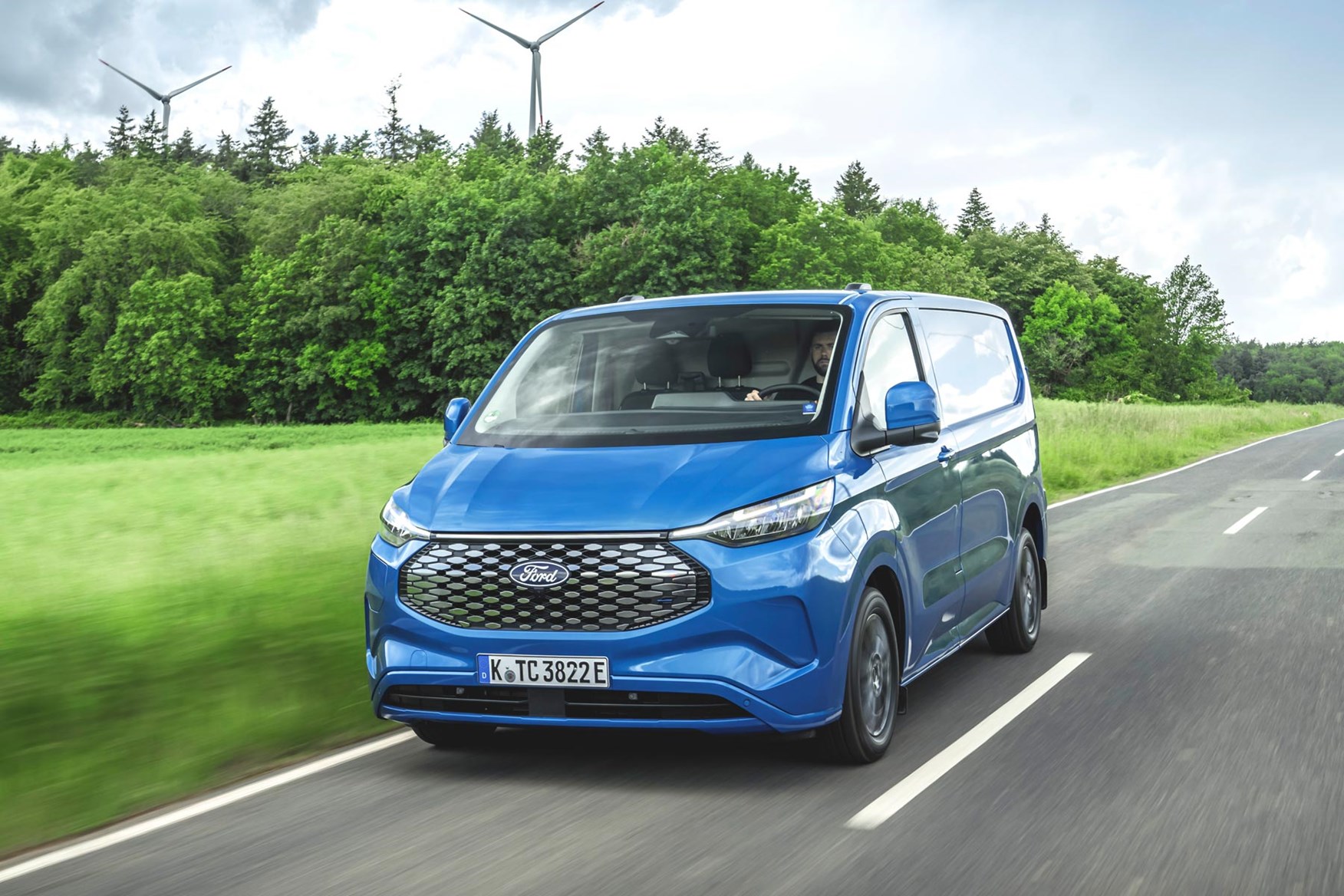
It does relatively well to make the most of that, with Ford quoting an official miles-per-kWh figure for the various versions. The most economical Trend version has a rating of 2.80mpkWh, which is also good but not genre busting.
Ford E-Transit Custom servicing
Service intervals on the electric E-Transit Custom are simply every two years. Unlike the diesel and plug-in hybrid models there is no mileage requirement – you can do as many miles as you want in that time.
Ford E-Transit Custom warranty
It’s a pretty standard three-year warranty for the E-Transit Custom, with a 100,000-mile restriction.
Ford E-Transit Custom standard equipment
There are four versions of E-Transit Custom to choose from, although it could be argued that the MS-RT is more of a special edition. It’s an official feature on the Ford price list these days, though, and is now created in the factory rather than elsewhere.
What is missing, though, is the basic Leader model – that isn’t offered on the electric version. Below are the highlights of each model:
Ford E-Transit Custom Trend highlights
- LED headlights and taillights
- Signature BEV front grille
- Full-width light bar
- Air conditioning
- Heat pump
- Speed limiter (70mph on the 136hp, 80mph on the 218hp version)
- Front parking sensors
- Rear parking camera
Ford E-Transit Custom Limited highlights (above Trend)
- Body coloured front and rear bumpers
- 16-inch alloy wheels
- Load-through bulkhead
- Storage under passenger seat
- Heated driver and passenger seats
Ford E-Transit Custom Sport highlights (above Limited)
- 17-inch alloy wheels
- Dual-zone air conditioning
- Sport comfort drivers seat
- Close assist door
- Stripes on bonnet
- Rear spoiler
- Electric tech still fairly new in vans
- Overall van new from ground up
Ford is late to the electric van game compared to some rivals, like Renault, so there isn’t loads of historical data to draw on when it comes to reliability of its EVs. Some of the brand’s early electric cars had a few issues when they were sold in the US, but these are said to have been ironed out and there have been no major reports in the UK thus far.
- Excellent levels of kit
- Top-level Platinum rating from Euro NCAP
The trend is for vans to get more safety equipment, and the Transit Custom has moved things on in this area. The goal was for it to get a strong rating from Euro NCAP and Ford has achieved that with a Platinum score.
Ford E-Transit Custom safety
The Euro NCAP rating system for vans uses a colour-coded scale, with the Ford’s Platinum score the highest you can get. It rated as ‘good’ in every area, scoring the maximum for lane support systems, speed assist and occupant status monitoring. The following kit is all offered as standard:
- Collision mitigation system
- Intelligent speed limiter
- Cruise control
- Lane keeping aid
- Speed sign recognition
- Wrong way alert
- Reverse parking aid
Trend then adds the front parking aid and rear parking camera, while cross traffic assist, reverse brake assist, a 360-degree camera for the first time on a van, and intelligent adaptive cruise control with stop and go are all on the options list.
Because the electric version doesn’t come with the basic Leader model, it comes with an alarm as standard, which is a bonus.
Which Ford E-Transit Custom is best for me?
We’ve only driven the higher of the two standard power outputs, so can’t comment on the 136hp version as yet. The step up in price between the two is notable, though, at around £4,000 – not far shy of 10% of the cash price.
This also brings you up to Sport trim, rather than the Limited that is the version we would go for on spec alone.
















